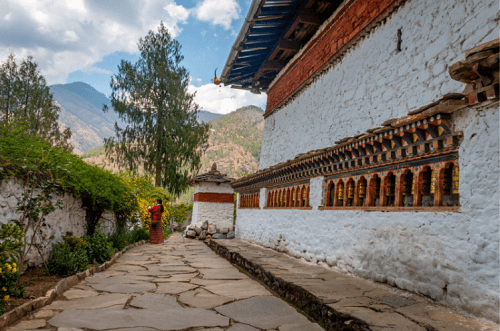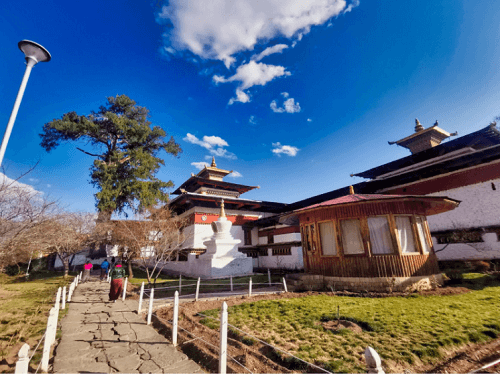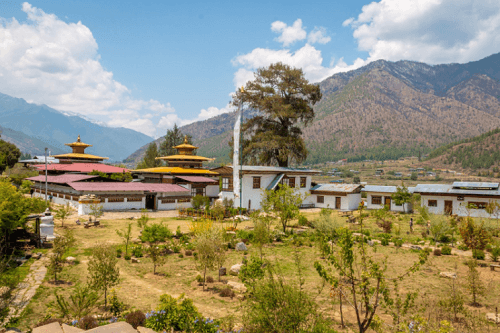Kyichu Lhakhang is located in the north of Paro town. It is the oldest and one of the most beautiful temples in Bhutan. It also goes by the names Lho Kyerchu or Kyerchu, and it is considered to be the sacred Jewel of Bhutan. The main temple of Jowo Lhakhang has roots as far back as the 7th century.
The temple was one of the 108 monasteries established by the Buddhist King Songstsen Gampo of Tibet. 12 of the 108 monasteries were built to pin down a demoness that laid across Tibet and Himalayas who prevented the spread of Buddhism. The twelve monasteries were believed to have been built at the twelve vital points of the demoness to subjugate her and to ensure the propagation of Buddhism. The 108 monasteries were said to be built in one day by artisans who were emanations of King Songtsen Gampo himself.

The original Kyichu Lhakhang was initially small in size but after multiple visits over the years by Buddhist saints, the temple expanded both in grandeur and size. In the 8th century, Guru Padmasambhava was believed to have visited the Kyichu Lhakhang and hidden a variety of treasures in the temple. Guru Padmasambhava hid many spiritual Ters (profound treasures) in Tibet, Bhutan and other parts of the Himalayan region. These treasures were to be discovered at certain times, places and under auspicious circumstances by Tertons (Treasure Revealers). The treasures comprise sacred teachings, statues, or relics, which would greatly benefit sentient beings at the time of discovery.
Zhabdrung Ngawang Namgyal took over the temple in 1674. The temple was later reconstructed in the year 1836-1838 by the 25th Je Khenpo Sherab Gyaltshen. In 1968, a new structure of the temple was built and named Guru Lhakang. The extension was made by the Royal Queen Mother Ashi Kezang Choden Wangchuck. Other Buddhist Saints that visited Kyichu Lhakhang temple for prayers also created an impact by expanding the temple. The prominent Buddhist saints who visited the temple in the 8th century were Phajo Dugom Zhigpo, Lam Kha Nga and Guru Rinpoche.

Highlights of Kyichu Lhakhang
As one walks toward Kyichu Lhakhang, the environment is quiet and serene. The ancient monastery is a fantastic place where you will find elderly pilgrims circumambulating around the temple as they spin the prayer wheels.
Inside the inner courtyard, there is a painting of the King named Gesar of Ling on the wall just near the entrance. The king was a renowned warrior in Tibet, and his epic poem is the longest in the world according to history.
The Kyichu Lhakang conceals the statue of Jowo Jamba originally from the 7th century. The icon is one of the greatest treasures of the valley. There is also another statue of Chenrezig outside the shrine that has 1000 arms and 11 heads. There is the wooden floor that has grooves worn by the generations of prostrators. The main entrance door is coated with gold. Kyichu Lhakhang holds ancient relics and the floor of the main temple constructed with wood decorated with turquoise and other precious stones and gems.
The structure next to Kyichu Lhakhang is the Guru Lhakhang which consists of Kurukulla and a 5-meter high statue of Guru Rinpoche holding an arrow made of flowers and a bow. On the outside of the temple, there are two orange magical trees that bear fruits throughout the year. There are also monk houses, prayer wheels, Lenza script on tiny prayer wheels.
Kyichu Lhakhang is a place of art and culture that is very important to historians, art connoisseurs and visitors all around the globe. This ancient monastery is a popular tourist spot for visitors. Sometimes, travellers even meditate at the temple.
Can visitors receive blessings or participate in religious rituals at Kyichu Lhakhang?
Yes, visitors are welcome to receive blessings from the resident monks and participate in religious rituals such as lighting butter lamps, circumambulating the temple, or making offerings at the shrines.
What is the best time of year to visit Kyichu Lhakhang?
The best time to visit Kyichu Lhakhang is during the spring and autumn months (March to May and September to November) when the weather is mild and the surrounding landscape is lush and green. Find out the best time to visit Bhutan.
Find out what are the other popular tourist attractions in Paro.

